In the Fuji-Hakone-Izu National Park sits Japan’s highest peak, Mount Fuji. It is a dormant stratovolcano that reaches 3 776m above sea level and has not erupted since the year 1707.
Mount Fuji has been deemed a UNESCO World Cultural Heritage Site and is considered sacred by the people of Japan. It is a spectacle that can be seen for miles! Trekking Mount Fuji is considered as one of the best hikes in Asia.
Below is a complete guide to hiking Mount Fuji, one of the most beautiful mountains in the world. I've included information on the different routes to the summit, the costs and preparation involved, as well as information on where to stay and what to bring.
This article contains affiliate links. It won't cost you extra, but if you buy something using our links, it might help us keep the site alive!
Mount Fuji Hiking (11 FAQs)
What are the different hiking trails to summit Mount Fuji?
There are four routes to the summit of Mount Fuji, the most popular of which is the Yoshida Trail. We’ve listed the trails below beginning with the most popular route. Each trail begins at a designated 5th Station.
Trekking Mount Fuji is popular amongst locals and tourists. It can be quite the social experience. However, if you are looking for some solitude, there are trails quieter than others.
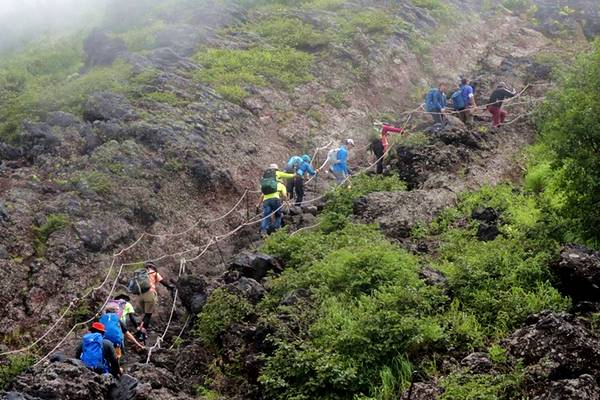
1. The Yoshida Trail
- Altitude: 2 300m
- Distance: 13 kms
- Ascent Time: 6 hours
- Decent Time: 4 hours
The Yoshida Trail is by far the most popular trail to summit Mount Fuji and is very crowded throughout the hiking season. Beginning at the Fuji-Subaru Line 5th Station, the path zigzags up the mountain on the north side giving you some epic views.
The trail is relatively flat and it’s a well-established path, making it the easiest trail to the summit There are shops, information offices and public toilets available and this route has the largest number of mountain huts available. You will be using a different trail to descend and there are no mountain huts on the way down, so keep this in mind when planning your trek.
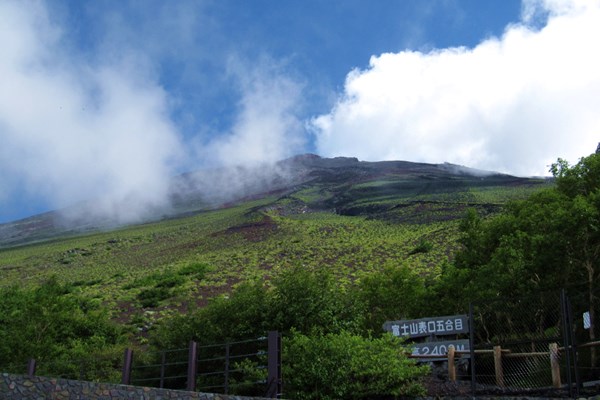
Photo by jenterri
2. The Fujinomiya Trail
- Altitude: 2 400m
- Distance: 7.6 kms
- Ascent Time: 5 hours
- Decent Time: 3 hours
This trail is the second most popular on the mountain. It begins at the Fujinomiya Trail 5th Station and leads to the summit from the south side of the mountain. It can become crowded due to the popularity of being closer to the summit than the other routes.
There is only one shop, an information office and public toilets available on this route. The Fujinomiya Trail is rocky and steep, so if you decide to hike this path, make sure you are well prepared, have good experience and are fit to hike in this terrain. This trail has mountain huts available at every station and the same path is used to descent.
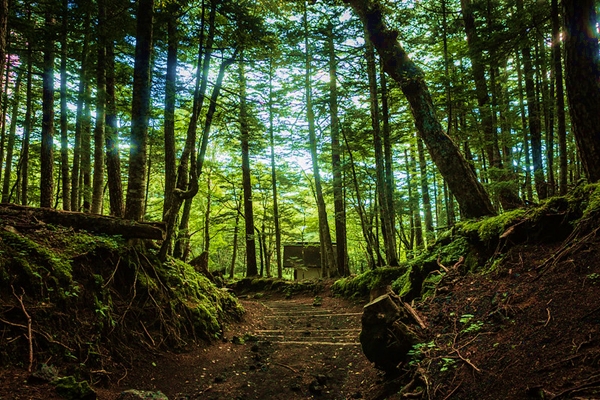
3. The Subashiri Trail
- Altitude: 2 000m
- Distance: 12 kms
- Ascent Time: 6 hours
- Decent Time: 4 hours
You’ll get some of the best sunrise views on this route!
The Subashiri Trails starts at the Subashiri Trail 5th Station and leads to the top of the mountain from the east side. The path slopes gently towards the summit and it’s more forested than the other three trails meaning you’ll have more shade cover on this route.
Bring a headlamp or flashlight if you’ll be hiking later in the day because it can be difficult to navigate the forest in the dark. The path meets with the Yoshida Trail from the 8th Station to the summit, so be aware that at this point it will become crowded.
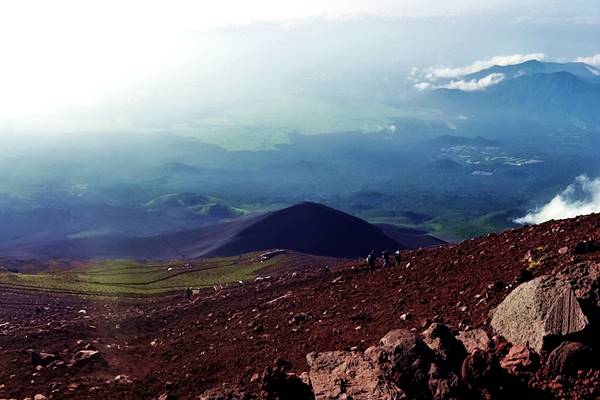
Photo by WorldContributor
4. The Gotemba Trail
- Altitude: 1 450m
- Distance: 19.5 kms
- Ascent Time: 8 hours
- Decent Time: 4 hours
Important Note on the descent: The descent on the Subashiri Trail and the Gotemba Trail is a fun experience because you get to go straight down on a trail of volcanic gravel. It’s like sand and that you can coast down the mountainside like riding a dune. In Japanese this ‘Sand run’ is called ‘Sunabashiri’. It’s a good idea to pack some goggles and gaiters to keep the sand out of your shoes and pebbles and eyes.
This is the least crowded trail to the summit of Mount Fuji. This hike is the longest and most strenuous route of the three. The Gotemba Trail takes you up the southeast side of the mountain and gives you a fantastic view of Lake Yamanaka. There are fewer mountain huts available on this route which is something to consider when planning your trek.
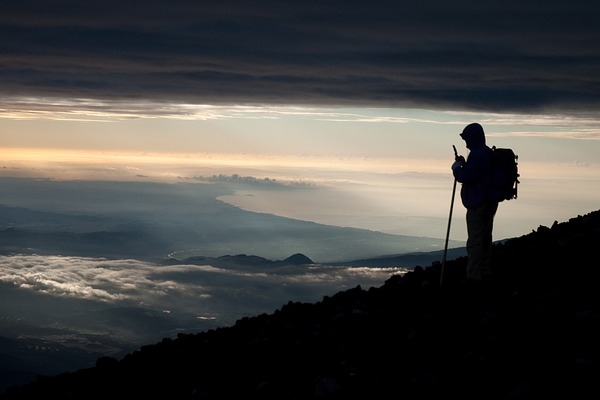
How difficult is it to Hike Mount Fuji?
Mount Fuji’s summit sits at 3 776m above sea level. There are areas with harsh elevation, steep inclines and the weather can be extremely unpredictable.
Thunderstorms, downpours, snow storms and hail can happen at any time and so it is necessary to be prepared for all weather conditions. At the same time, preparing yourself for hiking at high altitudes and educating yourself on the signs and symptoms of altitude sickness will go a long way to prepare.
While it may sound daunting, with the proper gear, training and planning, you will be able to reach the summit. Bullet climbing or climbing without taking a rest overnight is not recommended. Altitude sickness and injury are frequent in hikers who attempt the hike in one day. Pace yourself and spend the night sleeping on the mountain side!
You may also like: Best hikes in Japan
When is the best time to trek Mount Fuji?
The official hiking season for Mount Fuji is from July to September. The trails are clear of snow, the weather is mild, and all hiking facilities are open and available. While this is the busiest time on the mountain, I highly recommend hiking during this peak period if you have no previous hiking experience.
Late July to early august will give you the best clear skies and warm temperatures that you can get.
Quick Tip: If you want to avoid the big crowds during the peak hiking season, consider trekking Mount Fuji on a weekday during the first two weeks of July. This is before the school holidays begin in Japan.
If you’re hiking from the end of July to the end of August, the mountain will be packed with tourists and locals on holiday. Saturdays are the most crowded on the mountain and no matter what day you summit, there is always a crowd during sunrise!
During the off season, it is still possible to summit Mount Fuji; however it is not a good idea to attempt this if you have no prior experience trekking at high altitudes. Rescue personnel will not be readily available during this time, most mountain huts are closed, and transport is limited. These are things to keep in mind before attempting an off-season hike to Mount Fuji. It is assumed that if you hike during this time, you will be climbing at your own risk.
From late November to March/April is winter time in Japan. It is not recommended to hike Mount Fuji during this time as it will be extremely dangerous to summit in the snowy and unpredictable weather conditions.
Do I need to train for the Mount Fuji Trek?
Over 500 000 people summited Mount Fuji in one year. This makes it the most summited mountain in the world. However, some prior training is expected when hiking at a high altitude.
Hike a few times a week and add some elevation to your path if possible. Regularly running or jogging will help to prepare you for this trek. Get some cardio in to your routine and work on your leg strength. Some sections are steep and rocky and require stamina and strength to persist to the top.
While you don’t need to become a marathon runner or a body builder to consider hiking Mount Fuji, having a good physical condition will go a long way to helping you summit this mountain.
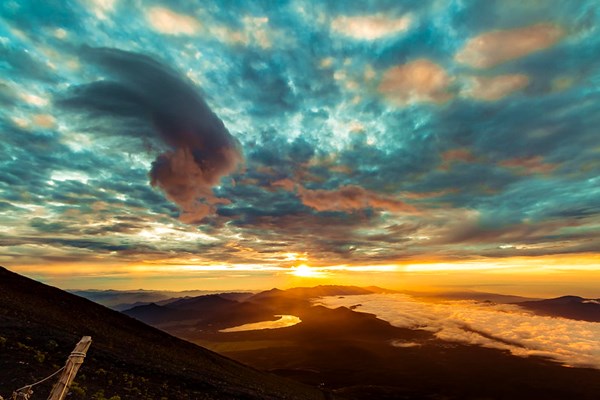
What accommodation is available on Mount Fuji?
There are no camping sites on Mount Fuji and camping is not permitted on the mountain. Mountain huts are available on all trails, and it is a good idea to book ahead of time to ensure you do not miss out. The huts will get full very quickly during peak seasons, and many will not be open during the off seasons.
There is also free WIFI available in all the huts on the mountain.
Mountain huts do not have handwashing or bath facilities and they may not accept payment with cards. The mountain huts are not considered luxury accommodations and you will be staying in close proximity to the other hikers, so be sure that this is something you are comfortable with.
What other costs do I need to consider for Hiking Mount Fuji?
There are several costs you need to consider when planning a hike up Mount Fuji.
Admission Fees: Admission fees are paid at each trailhead and cost about 1000 Yen per person. This fee covers conservation of the environment, safety precautions on the trails and cover any expenses that may arise from the number of hikers that summit Mount Fuji every season.
Toilets: All toilets are eco-friendly and use oyster shells, sawdust and other eco-friendly biodegradable products to treat waste. This initiative is further supported by a small fee to utilize the toilet facilities, so be sure to bring your Yen coins for this reason. The average price for entry is 100 – 200 Yen.
Mountain Huts: The huts are available overnight for around 7000 – 9000 Yen. Some Mountain Huts will provide two meals which would be included in the price, so check this when you make your booking. Some huts also have a rest option where you do not need to stay overnight, this costs around 1000 – 2000 Yen per hour.
Food / Water / Hiking Accessories: Some stations and mountain huts have stores which sell food supplies, water and hiking provisions such as oxygen. If you require stocking up along the trail, then be sure to bring some cash for your shopping needs. A bottle of water can cost up to 500 Yen.
Other costs: Meals at the mountain huts (if not included in accommodation price), souvenirs, offerings at shrines and collecting branding iron-stamps on your wooden hiking stick.
Important Note: Purchase your necessities when you are lower on the mountain, the prices get higher the higher you get on the mountain.
Do I need a permit for hiking Mount Fuji?
Summiting Mount Fuji does not require a permit; however, every person has to complete and submit a Climbing Plan.
This is so that emergency responses have an idea of what route you have planned to take, your schedule, and what equipment you have with you in the case of an accident or disappearance. This helps the emergency response teams reach you as soon as possible.
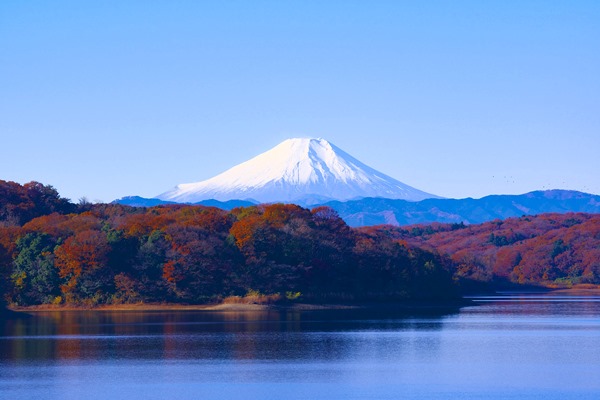
Are there any rules or regulations to be aware of before climbing Mount Fuji?
The Fuji-Hakome-Izu National Park is a designated as a Special Place of Scenic Beauty and is a World Heritage site, meaning there are a few rules and regulations in place to protect the mountain. These acts are punishable by law.
- Defacing Mount Fuji
- Disturbance of plants and animals
- Taking lava from the area
- Camping or fires
- Releasing pets or animals into the area
- Planting seeds or seedlings in the area
There is a general ‘Country Code’ that includes the above as well as littering, straying off trails, and just general respect for the mountain and local people. Please always respect your environment so that gems like these can be preserved for future generations to experience.
How do you get from Tokyo to Mount Fuji?
You’ll find Mount Fuji about 100 kilometres from Tokyo. The easiest way to get to Mount Fuji is to take the bus from Shinjuku Highway Bus Terminal which will take you to the Subaru 5th Station, the beginning of the Yoshida Trail.
The bus takes about 2.5 hours to get there, and tickets can be booked online in advance.
For a more scenic route to the mountain, consider taking the train which will take you through beautiful landscapes and takes about 4 hours to reach the station.
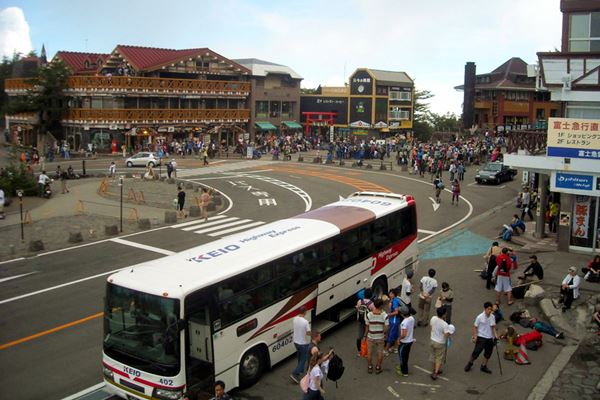
What do I need to pack to hike Mount Fuji?
One of the most important items to pack for your Mount Fuji trek is warm clothing, regardless of the season. Temperatures at the summit can reach below 6 degrees Celsius. Having rainproof clothing is also essential due to the unpredictable weather conditions.
Some important considerations when packing for your trek:
- Check your gear before you leave to ensure it is all in good condition
- Take unpredictable weather conditions into account
- Take unexpected delays due to these changes in weather into account
Water
While you can stock up on water during your hike at the mountain huts and stores, there is nowhere available to purchase water on your descent and so you will need to keep this in mind.
Bring 1L of water for your climb and stock up at the mountain huts. You’ll need around 3 -4 Litres for your entire hike. Make sure to keep hydrated as needed, dehydration can lead to altitude sickness.
You might want to use a hydration bladder for this hike. We recommend the HydraPak Shape-Shift Reservoir.
What gear, clothing and accessories do I need to Hike Mount Fuji?
Below are our recommendations for gear, clothing and accessories you'll need to hike Mount Fuji.
Gear
- Headlamp
- 30L backpack with hip strap
- Collapsible Hiking Poles
- Backpack rain cover
- Antibacterial hand gel
- Snacks
- First aid
- Insect spray
- Soap
- Sunscreen (apply frequently)
- 1 – 2 liters water
Clothing
- Zip off hiking trousers
- Thermal leggings
- Rainproof hiking pants
- Hiking Shirt
- Fleece Jacket
- Waterproof Jacket
- Fleece Gloves
- Good hiking boots
- Hiking socks
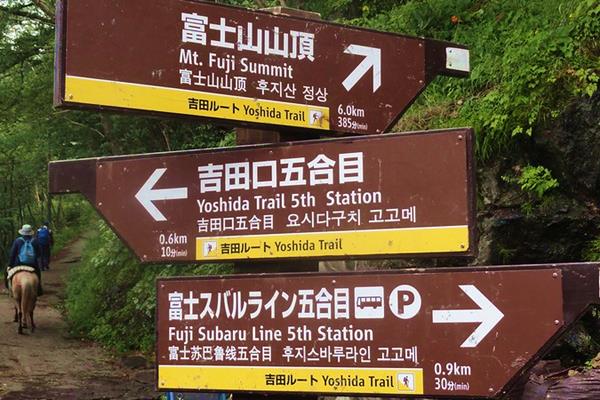
Is it safe to hike Mount Fuji?
There are precautions to take when hiking any mountain trail and Mount Fuji is no exception. Unpredictable weather is common on the mountain and should be well prepared for.
When descending, take care to not rush down the mountainside. While it may seem easy, there are many instances of falling and injury on the descent. Don’t underestimate your journey back down the mountain.
During the climbing season, there is cell phone reception on the mountain. In the event of an emergency, there are emergency contact numbers below that can be used to reach help:
- For the Yoshida Trail: Dial 0555-72-1477 (Mt Fuji 5th Station)
- For the other three trails: Contact 110 (Police) / 119 (Fire/Ambulance)
Please be aware that if you choose to hike outside of the hiking season, emergency services will not be on hand and will take longer to assist you during this time. Despite this, hiking is always done at your own risk.
Most accidents and injuries are caused by underestimating the cold temperatures leading to hypothermia, a lack of hiking experience at high altitudes and insufficient gear.
Continue browsing
See more information on Asia. Or check out these other Asian Hiking articles:
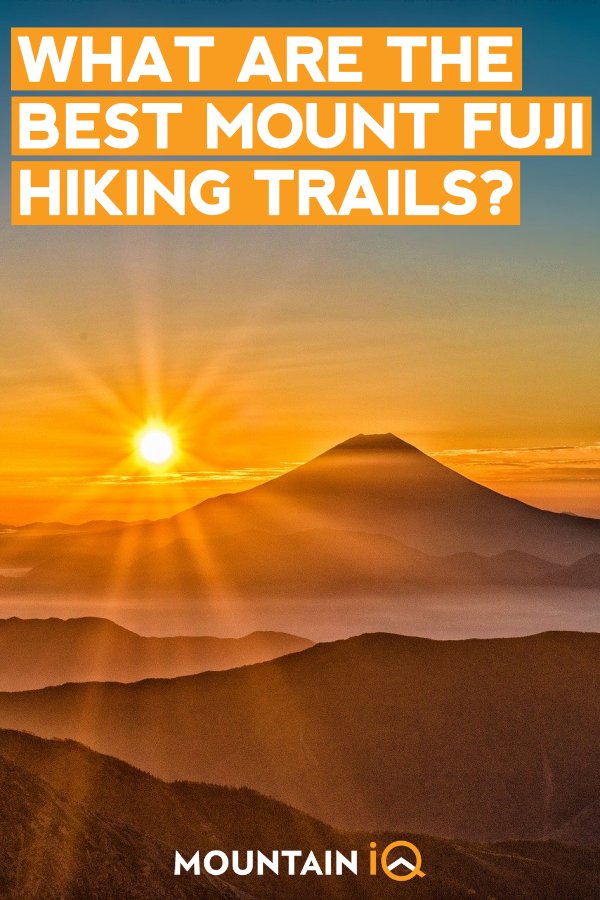

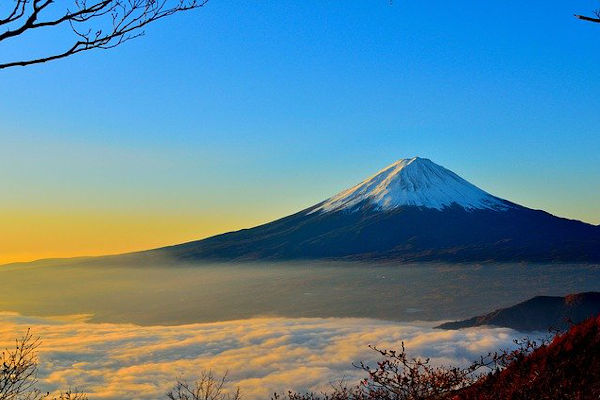
Thank you very much for sharing this information with us. It is clear and well written. I have a question that would like to confirm it with you. In your article, the altitudes in all 4 trails indicate the altitude of each trailhead not the Elevation Gain (EG), am I right?
That’s correct, the values are altitude not EB.
Very informative. Thank you! Since train or bus is required to get to the 5th station, what time of day is best to begin the Yoshida Trail?
H Diana, it’s best to start as early as possible. The hike up from the 5th station takes about 4-5 hours (including crater rim), and 3-4 hours decent. The 5th station closes at 19:00pm. Some people take 10-12 hours to complete the hike, so an early start is better. If you want to make sunrise, you should start around 12:00-01:00am.